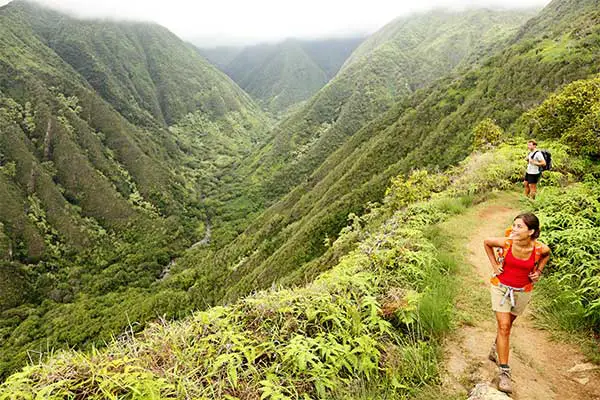Maui is home to many beautiful hiking opportunities. While exploring Maui’s natural offerings is exciting, there are rules to follow. Why?
Well, as with any hiking location, there are signs for hiker safety designed to protect them from getting hurt or ending up in a fatal accident. Unfortunately, not all hikers heed these warnings. Hence why the Hawaii Senate is taking action to further incentivize hikers to obey the warning signs, lest they get slapped with a rescue fine.

Hawaii Senate Pushes Bill to Make Hikers Pay for Rescue if They Disobey Signs
Table of Contents
It’s estimated that almost 1,000 rescues take place every year in Hawaii. Most of these rescues come about from hiker negligence. The signs posted on paths are very clear, so if problems arise, it’s usually due to people ignoring the signs and entering prohibited areas.
Recently, there was an instance in Hana (on the island of Maui) where three people ignored flash flood signs and were swept out to sea. Unfortunately, not all of them made it back—two were rescued, while one passed away. The cost of the rescue was great in more than one way.
With these preventable instances occurring so frequently, the Hawaiian Senate feels the need to take it a step further. Since the signs aren’t enough in some cases, they hope fear of a monetary fine will help prevent people from disobeying these crucial safety warnings. So, future hikers could have to pay back that cost to Maui’s rescue department(s).
What Does This Mean for Hawaii Hikers?
Warning and prohibited signs are placed on hiking trails in Maui for a reason. Since Hawaii’s ecosystem is so unique, tourists may be unfamiliar with some of the risks that come with it. So it’s important to pay attention and listen to the warnings. Do not enter prohibited areas.
That said, there’s still much beauty to be seen and experienced on Maui’s trails. The bill isn’t meant to scare people off—rather; it helps ensure that hikers can take in what Maui has to offer without getting hurt or worse.
Should something happen where you are in need of rescue on a hike, you should not hesitate to contact the fire department. However, these situations are most often easily avoided. Here are some tips to stay safe on your Maui hikes:
- Don’t hike alone if you can help it. Should you come into trouble, having someone there to get help is crucial.
- Bring plenty of water and snacks.
- Wear the appropriate attire. This means shoes with good traction and protective layers if necessary.
- Have a backup plan in place should something happen. Does your cell phone get service? Is your phone charged? Who will you call?
- Most importantly, obey the signs. They are there to keep you safe.
Some of Maui’s Most Popular Hikes
If you’re prepared for a hike and ready to obey trail signs, let the fun begin. Here are some of Maui’s best hikes.
Hosmer Grove Loop Trail
This half-mile trail is located just inside Haleakala National Park. While this trail lacks a little greenery, it’s home to some of Hawaii’s famous sandalwood trees. This hike is well known for its otherworldly atmosphere.
Wai’anapanapa State Park Trails
These trails are located in the Hana Highway region. Here you will see black sand, which is a big reason many are attracted to this area. The park also has other interesting views including lava rocks, lava caves, a sea arch, a blowhole, and wind-twisted foliage.
Some of the hiking trails come across wet caves and lava tubes as well.
La Perouse Bay Trails
These trails are home to lava rock created by Haleakala’s last eruption in the late 1700s. Today there is a monument and ruins of native Hawaiians who once made their home on these sharp rocks.
You can walk through the lava rocks and see what the sea estuaries have to offer. This is also a hangout for dolphins, so keep an eye out. Remember to bring sunscreen to this location and be ready for some wind.
Twin Falls Trail
Another Hana Highway trail, this one is located across a bridge over the Ho’olawa Nui stream. As the name suggests, there are various waterfalls along the trail. There is a rustic map drawn onto a rock at the beginning of the trail to guide your journey. The entire loop should take about an hour.
Kuloa Point Trail
This trail is a bit beyond Hana. It’s a short hike that is great for families. It takes you the opposite direction of Pipiwai Trail (discussed below), to incredible pools that spill into the ocean.
You might see locals even jumping into the pools. But remember that this is risky and you should check with rangers to make sure swimming conditions are safe. If the flow of the stream is too heavy, it’s not a good idea to swim.
‘Iao Valley State Park
Technically not a trail, this location is still a great place to view some scenery. The area is vibrant and green, with a natural rock formation called the ‘Iao Needle. This stone that comes up from the valley floor is a volcano remnant and reaches 1,200 feet tall from the valley floor.
Around the ‘Iao Needle is a walkway and tropical garden. The valley is surrounded on all sides by the Pu’u Kukui Crater, which was the site of a famous historical Hawaiian battle.
Waikamoi Ridge Trail
Yet another trail along the road to Hana Highway, this one is a short loop in a jungle-ish area that is great for families. An extended path leads up to a picnic area for those who want to spend some time here.
Waihee Ridge Trail
This is the trail for those who love to climb. Starting with a steep incline at the beginning, it goes along the spine of Waihee Valley. The views from the top are incredible if the clouds are clear.
Sliding Sands Trail
This trail is in Haleakala National Park, on top of the Haleakala Volcano. Unlike some other trails, this one can get a bit cold, so it’s best to dress warmly. On this trail, you’ll get to see inside the volcano itself and you can even hike down into it a little ways. Just keep in mind that climbing back out will be an uphill battle…literally.
Also remember that it’s important to stay on the trail for this hike because you could damage the rare and native Silverswords that grow here.
Pipiwai Trail
This trail is located at the Oheo Gulch (7 Sacred Pools). It’s a 4-mile round trip that takes you through sites like a bamboo forest and a valley with multiple waterfalls coming down the sides. It’s a wonderful trail for taking some really cool photos.
If you’re planning to take in Maui’s beauty via a hike, you’re in for a wonderful adventure. Just be sure to be mindful of trail signs and be prepared.
